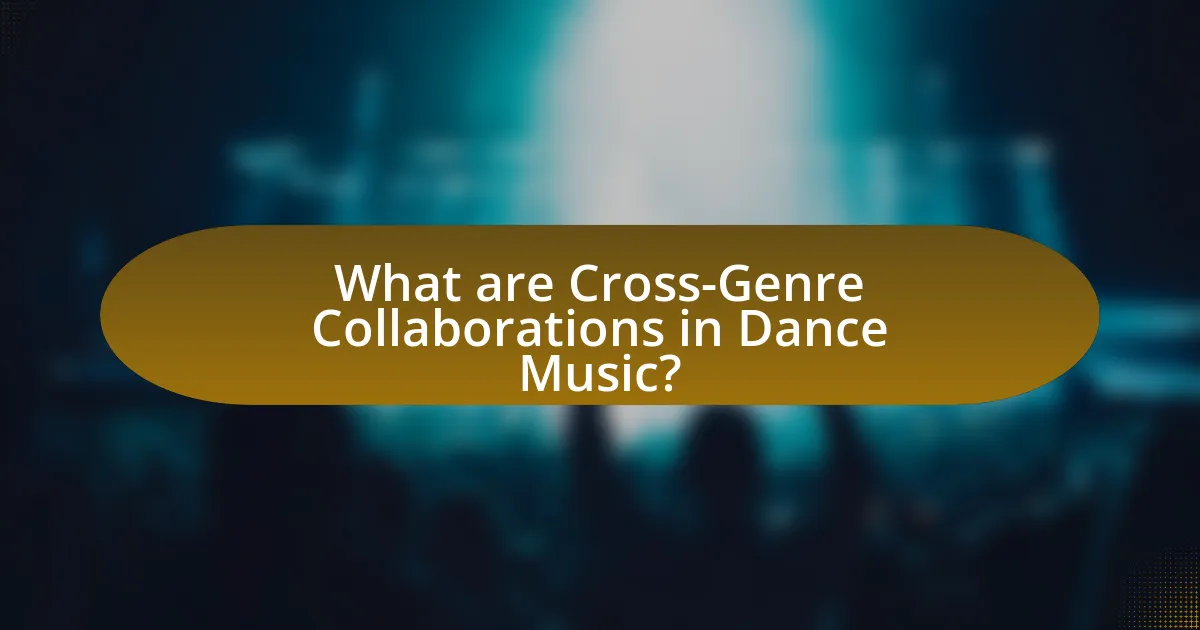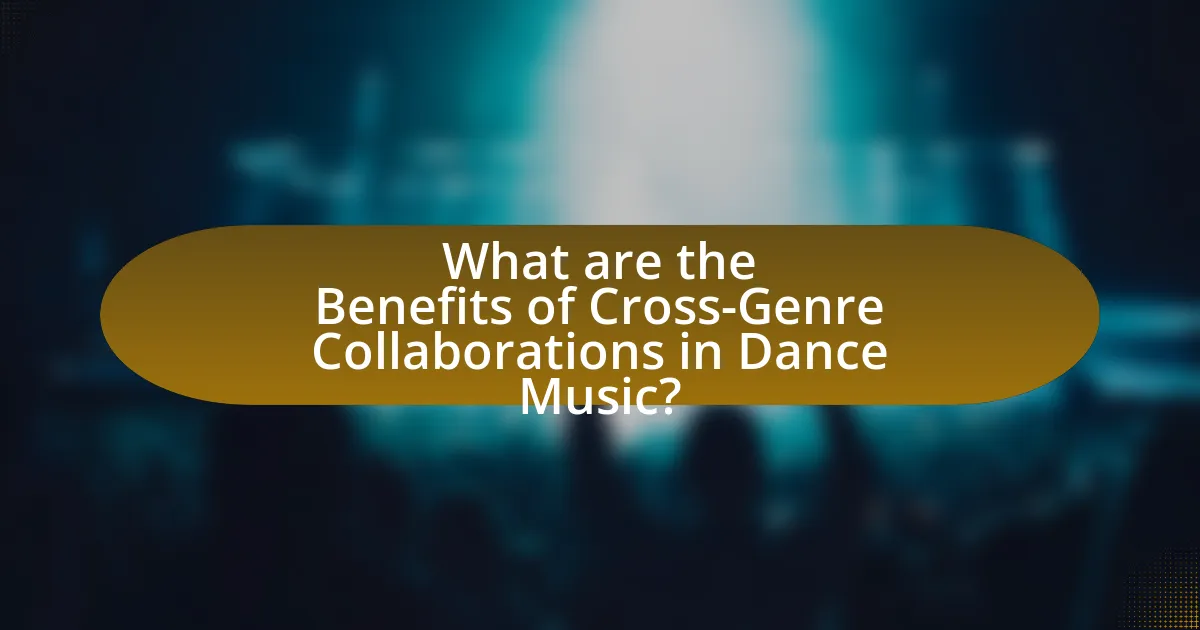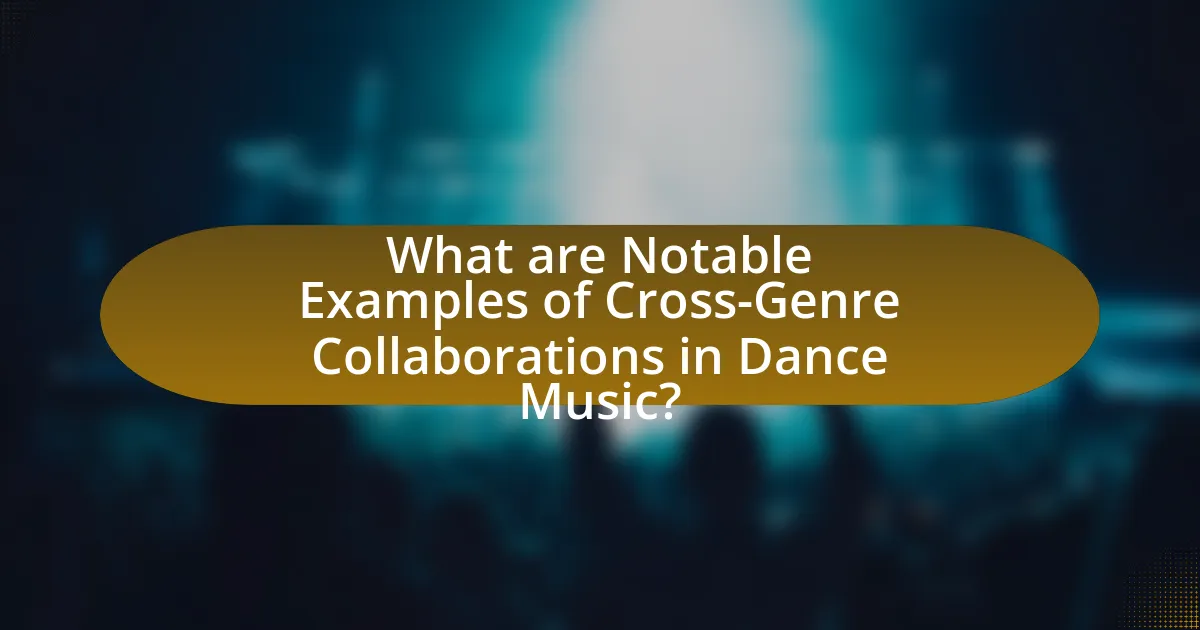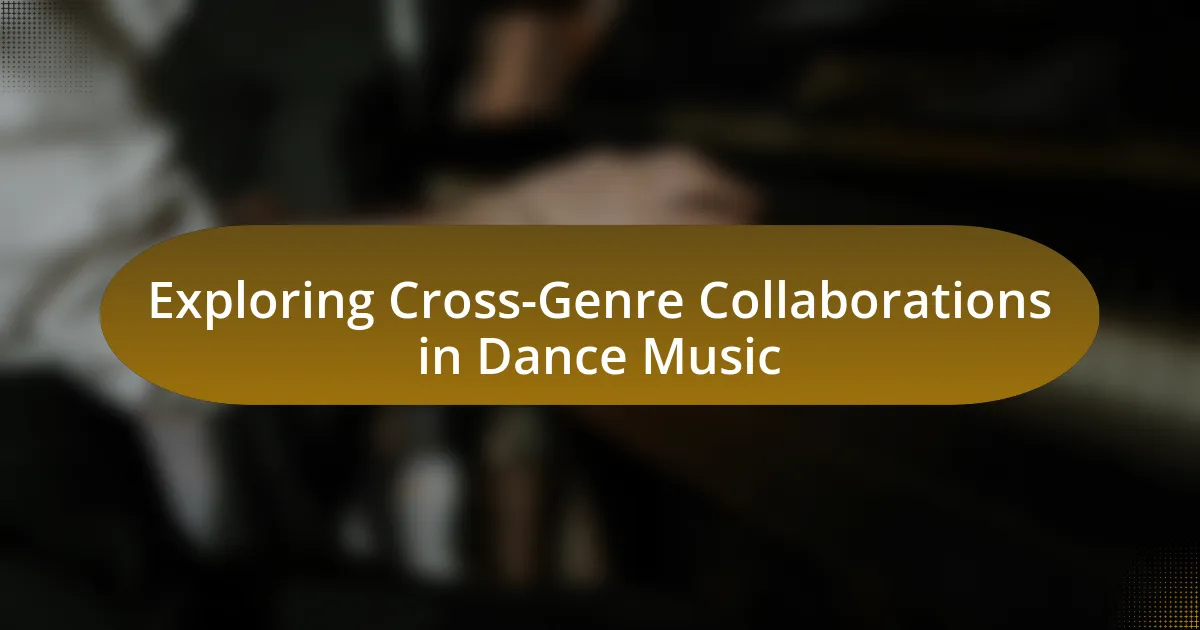Cross-genre collaborations in dance music involve partnerships between artists from different musical genres, resulting in innovative tracks that blend diverse styles. These collaborations significantly influence the evolution of dance music by introducing new sounds and techniques, expanding audience reach, and enhancing commercial viability. Commonly blended genres include pop, hip-hop, and rock, which reshape audience perceptions and foster a more inclusive musical landscape. The article explores the benefits, challenges, and economic advantages of these collaborations, as well as notable examples and best practices for artists engaging in cross-genre projects.

What are Cross-Genre Collaborations in Dance Music?
Cross-genre collaborations in dance music refer to the creative partnerships between artists from different musical genres to produce tracks that blend diverse styles and influences. These collaborations often result in innovative sounds that attract wider audiences, as seen in the fusion of electronic dance music with hip-hop, pop, or rock elements. For instance, the collaboration between DJ Snake and Lil Jon on “Turn Down for What” exemplifies how merging genres can lead to commercial success, achieving multi-platinum status and significant chart performance.
How do cross-genre collaborations influence the evolution of dance music?
Cross-genre collaborations significantly influence the evolution of dance music by introducing diverse sounds and techniques that expand its creative boundaries. These collaborations often blend elements from genres such as hip-hop, rock, and pop, resulting in innovative subgenres like EDM and trap. For instance, the collaboration between David Guetta and Sia on “Titanium” showcases how pop vocals can enhance electronic beats, leading to mainstream acceptance of dance music. Additionally, the fusion of styles can attract wider audiences, as seen with the success of artists like Calvin Harris, who incorporates various musical influences into his tracks. This blending not only enriches the dance music landscape but also drives its commercial viability, evidenced by the rise in streaming numbers and festival attendance for cross-genre acts.
What genres are commonly blended with dance music?
Genres commonly blended with dance music include pop, hip-hop, rock, and electronic genres like house and techno. These collaborations enhance the appeal of dance music by incorporating diverse elements, such as catchy melodies from pop, rhythmic verses from hip-hop, and the energy of rock. For instance, the fusion of dance music with pop has led to chart-topping hits, exemplified by artists like Calvin Harris and Dua Lipa, who successfully merged these styles to create mainstream success.
How do these collaborations reshape audience perceptions?
Collaborations in dance music reshape audience perceptions by blending diverse musical styles, which broadens listeners’ appreciation for different genres. For instance, when a house music producer collaborates with a hip-hop artist, it introduces fans of both genres to new sounds and cultural elements, fostering a more inclusive musical landscape. Research indicates that such cross-genre collaborations can increase audience engagement and expand listener demographics, as seen in the success of tracks like “One Kiss” by Calvin Harris and Dua Lipa, which topped charts across multiple genres. This blending not only enhances the appeal of the music but also challenges preconceived notions about genre boundaries, ultimately transforming how audiences perceive and interact with various musical forms.
Why are cross-genre collaborations becoming more popular?
Cross-genre collaborations are becoming more popular due to the increasing demand for musical diversity and innovation among listeners. This trend is driven by the rise of digital platforms that allow artists to reach wider audiences, enabling them to experiment with different styles and genres. For instance, collaborations between electronic dance music and hip-hop artists have gained significant traction, as seen in the success of tracks like “Old Town Road” by Lil Nas X and Billy Ray Cyrus, which blends country and rap elements. Additionally, data from the music industry shows that songs featuring multiple genres often achieve higher streaming numbers, reflecting consumer preferences for eclectic sounds.
What role does technology play in facilitating these collaborations?
Technology plays a crucial role in facilitating cross-genre collaborations in dance music by providing tools for communication, production, and distribution. Digital audio workstations (DAWs) enable artists from different genres to collaborate remotely, allowing them to share and edit music tracks in real-time. Additionally, platforms like SoundCloud and Bandcamp facilitate the sharing of music across diverse audiences, promoting genre-blending. The rise of social media also enhances networking opportunities, enabling artists to connect and collaborate regardless of geographical barriers. These technological advancements have led to a significant increase in cross-genre projects, as evidenced by the growing number of collaborations between electronic, hip-hop, and pop artists, which have reshaped the music landscape.
How do cultural trends impact the rise of cross-genre collaborations?
Cultural trends significantly influence the rise of cross-genre collaborations by fostering an environment of experimentation and blending of musical styles. As audiences increasingly embrace diversity in music, artists are motivated to collaborate across genres to reach wider demographics and create innovative sounds. For instance, the popularity of genres like hip-hop and electronic dance music has led to numerous collaborations, such as the fusion of pop and trap, which has seen artists like Billie Eilish and Lil Nas X achieve mainstream success. This trend is supported by data showing that streaming platforms, which promote genre-blending playlists, have increased listener engagement, further encouraging artists to explore cross-genre partnerships.
What challenges do artists face in cross-genre collaborations?
Artists face several challenges in cross-genre collaborations, primarily including differing creative visions, communication barriers, and audience expectations. Differing creative visions can lead to conflicts over artistic direction, as artists from distinct genres may have unique approaches to composition and performance. Communication barriers often arise due to varying terminologies and practices within different musical styles, making it difficult for artists to effectively convey their ideas. Additionally, audience expectations can pose a challenge, as fans of specific genres may resist or critique the fusion of styles, potentially impacting the commercial viability of the collaboration. These challenges highlight the complexities artists navigate when attempting to blend diverse musical influences.
How do differing artistic visions affect collaboration outcomes?
Differing artistic visions significantly impact collaboration outcomes by influencing the creative process and the final product. When artists have contrasting perspectives, it can lead to innovative ideas and unique blends of styles, enhancing the overall quality of the collaboration. However, these differences can also result in conflicts, miscommunication, and a lack of cohesion, which may hinder the project’s success. For instance, a study by the Journal of Creative Behavior found that successful collaborations often involve a balance between diverse artistic visions and a shared understanding of goals, demonstrating that while differing visions can spark creativity, they must be managed effectively to achieve positive outcomes.
What are the logistical challenges in producing cross-genre music?
Producing cross-genre music presents logistical challenges such as coordinating schedules among diverse artists, managing varying production techniques, and reconciling different creative visions. These challenges arise because artists from different genres often have distinct workflows and timelines, making collaboration difficult. For instance, a hip-hop artist may prioritize lyric writing and beat production, while an electronic music producer might focus on sound design and arrangement. Additionally, the need for specialized equipment and software that caters to different genres can complicate the production process, requiring additional resources and time. This complexity is evidenced by the fact that successful cross-genre collaborations, like those between electronic and hip-hop artists, often involve extensive planning and negotiation to align artistic goals and production methods.

What are the Benefits of Cross-Genre Collaborations in Dance Music?
Cross-genre collaborations in dance music enhance creativity and broaden audience reach. By merging different musical styles, artists can innovate and produce unique sounds that attract diverse listeners. For instance, collaborations between electronic dance music (EDM) and hip-hop artists have led to chart-topping hits, demonstrating the commercial viability of such partnerships. Additionally, these collaborations often result in increased exposure for lesser-known artists, as they tap into each other’s fan bases, thereby expanding their market presence. This blending of genres not only enriches the music landscape but also fosters a culture of experimentation and collaboration within the industry.
How do these collaborations enhance creativity in music production?
Collaborations in music production enhance creativity by merging diverse musical styles and perspectives, leading to innovative soundscapes. When artists from different genres collaborate, they bring unique techniques, influences, and ideas, which can result in unexpected combinations and fresh approaches to composition. For instance, the collaboration between electronic and hip-hop artists has led to the creation of sub-genres like trap, which blends rhythmic elements from both styles, showcasing how cross-genre partnerships can push creative boundaries. This blending of influences not only broadens the artistic palette but also fosters experimentation, encouraging artists to step outside their comfort zones and explore new sonic territories.
What unique sounds emerge from blending different genres?
Blending different genres creates unique sounds characterized by the fusion of distinct musical elements, rhythms, and instrumentation. For instance, the combination of electronic dance music (EDM) with hip-hop often results in a rhythmic complexity that incorporates rapping over electronic beats, creating a dynamic soundscape. Similarly, the merging of jazz with funk can produce intricate melodies and improvisational elements layered over a strong rhythmic foundation. These genre fusions not only expand the sonic palette but also attract diverse audiences, as evidenced by the popularity of artists like Daft Punk, who blend house music with disco, resulting in a sound that is both nostalgic and innovative.
How do collaborations expand an artist’s reach and audience?
Collaborations expand an artist’s reach and audience by leveraging the fan bases of multiple artists, thereby increasing exposure and engagement. When artists from different genres collaborate, they introduce each other to their respective audiences, which can lead to a significant increase in followers and listeners. For example, the collaboration between Diplo and Madonna on the song “Bitch I’m Madonna” not only combined their distinct styles but also brought together their diverse fan bases, resulting in millions of views and streams across platforms. This cross-pollination of audiences is a powerful strategy in the music industry, as it allows artists to tap into new markets and demographics, ultimately enhancing their visibility and popularity.
What economic advantages do artists gain from cross-genre collaborations?
Artists gain significant economic advantages from cross-genre collaborations, primarily through expanded audience reach and increased revenue streams. By collaborating across genres, artists tap into diverse fan bases, which can lead to higher sales of music, merchandise, and concert tickets. For instance, a study by the University of Southern California found that artists who engage in cross-genre collaborations experience a 30% increase in streaming numbers compared to their solo work. This broader exposure not only enhances their marketability but also opens opportunities for sponsorships and partnerships, further boosting their financial prospects.
How do collaborations impact streaming and sales revenue?
Collaborations significantly enhance streaming and sales revenue by combining fan bases and increasing exposure. When artists from different genres collaborate, they attract listeners from both audiences, leading to higher streaming numbers and sales. For instance, the collaboration between Marshmello and Bastille on “Happier” resulted in over 1 billion streams on Spotify, showcasing how cross-genre partnerships can drive substantial revenue growth. Additionally, collaborations often generate buzz and media attention, further amplifying reach and sales potential.
What opportunities for live performances arise from these collaborations?
Collaborations in dance music create opportunities for live performances that include unique festival lineups, joint tours, and special event showcases. These collaborations often combine diverse musical styles, attracting broader audiences and enhancing the overall experience. For instance, artists from different genres can perform together, leading to innovative sets that feature a blend of their respective sounds, which has been shown to increase ticket sales and audience engagement at events. Additionally, collaborations can result in exclusive live performances that are marketed as unique experiences, further driving interest and attendance.
How do cross-genre collaborations influence the music industry?
Cross-genre collaborations significantly influence the music industry by expanding audience reach and fostering innovation. These collaborations allow artists to blend diverse musical styles, attracting fans from different genres and creating unique sounds that can lead to commercial success. For instance, the collaboration between Lil Nas X and Billy Ray Cyrus on “Old Town Road” merged country and hip-hop, resulting in a record-breaking chart performance and introducing hip-hop to a broader country audience. This trend has been supported by data showing that genre-blending tracks often achieve higher streaming numbers and chart placements, demonstrating the commercial viability of such partnerships.
What trends in the industry are driven by successful collaborations?
Successful collaborations in the dance music industry drive trends such as genre fusion, increased audience engagement, and innovative production techniques. Genre fusion occurs when artists from different musical backgrounds come together, creating unique sounds that attract diverse listener demographics. For instance, collaborations between electronic dance music (EDM) producers and hip-hop artists have led to chart-topping hits, demonstrating the commercial viability of blending styles. Increased audience engagement is evident as fans of both collaborating artists are drawn to the new music, expanding their reach and fan base. Additionally, innovative production techniques emerge from these partnerships, as artists share their expertise and experiment with new sounds, leading to fresh trends in music production. These trends are supported by data showing that cross-genre collaborations often result in higher streaming numbers and greater social media interaction, indicating their impact on the industry.
How do record labels respond to the rise of cross-genre music?
Record labels respond to the rise of cross-genre music by actively seeking and promoting artists who blend different musical styles. This strategy allows labels to tap into diverse fan bases and expand market reach. For instance, labels like Atlantic Records and Universal Music Group have signed artists who incorporate elements from genres such as hip-hop, pop, and electronic dance music, reflecting the growing trend of genre fusion. This approach is supported by data showing that cross-genre collaborations often lead to increased streaming numbers and chart performance, as seen with tracks like “Old Town Road” by Lil Nas X, which topped charts across multiple genres.

What are Notable Examples of Cross-Genre Collaborations in Dance Music?
Notable examples of cross-genre collaborations in dance music include “Where Are Ü Now” by Skrillex and Diplo featuring Justin Bieber, which blends electronic dance music with pop elements, achieving significant commercial success and critical acclaim. Another example is “Titanium” by David Guetta featuring Sia, which combines house music with pop and has been certified multi-platinum in several countries. Additionally, “Stay” by Zedd and Alessia Cara merges electronic music with pop, reaching high positions on global charts. These collaborations illustrate the successful fusion of different musical styles, expanding the reach and appeal of dance music.
Which artists have successfully collaborated across genres?
Artists such as David Bowie, Lady Gaga, and Lil Nas X have successfully collaborated across genres. David Bowie blended rock with electronic and pop elements, notably in his work with Brian Eno, which resulted in the influential “Berlin Trilogy.” Lady Gaga has collaborated with artists from various genres, including Tony Bennett in jazz and Blackpink in K-pop, showcasing her versatility. Lil Nas X gained fame for merging country and hip-hop with his hit “Old Town Road,” which topped charts across multiple genres. These collaborations illustrate the ability of artists to transcend traditional genre boundaries, creating innovative music that appeals to diverse audiences.
What are some landmark tracks that exemplify cross-genre collaborations?
Some landmark tracks that exemplify cross-genre collaborations include “Walk This Way” by Run-D.M.C. featuring Aerosmith, which fused hip-hop and rock, and “Old Town Road” by Lil Nas X featuring Billy Ray Cyrus, blending country and rap. These tracks achieved significant commercial success, with “Walk This Way” reaching number one on the Billboard Hot 100 in 1986 and “Old Town Road” holding the top position for a record-breaking 19 weeks in 2019. Their impact on music culture demonstrates the potential of cross-genre collaborations to create new sounds and reach diverse audiences.
How have these collaborations impacted the artists’ careers?
Collaborations in dance music have significantly enhanced artists’ careers by broadening their audience reach and increasing their marketability. For instance, when artists from different genres collaborate, they often tap into each other’s fan bases, leading to increased streaming numbers and social media engagement. A notable example is the collaboration between DJ Snake and Justin Bieber on “Let Me Love You,” which resulted in over 1 billion streams on platforms like Spotify, showcasing how cross-genre partnerships can lead to commercial success. Additionally, these collaborations often lead to critical acclaim, as they introduce innovative sounds and styles, further solidifying the artists’ reputations in the industry.
What lessons can be learned from successful cross-genre collaborations?
Successful cross-genre collaborations demonstrate the importance of innovation and audience expansion. These collaborations often blend distinct musical elements, creating unique sounds that attract diverse listener demographics. For instance, the partnership between the electronic artist Skrillex and the pop singer Justin Bieber resulted in the hit song “Where Are Ü Now,” which topped charts globally and showcased how merging genres can lead to commercial success. Additionally, such collaborations encourage artists to step outside their comfort zones, fostering creativity and artistic growth. The fusion of different styles can also enhance the overall quality of music, as seen in the collaboration between country artist Lil Nas X and rapper Billy Ray Cyrus on “Old Town Road,” which broke records for its genre-defying appeal.
What strategies do artists use to ensure successful collaborations?
Artists use clear communication and mutual respect as key strategies to ensure successful collaborations. Establishing open dialogue allows artists to express their creative visions and expectations, fostering a collaborative environment. Additionally, setting defined roles and responsibilities helps to streamline the creative process, ensuring that each artist contributes effectively. Research indicates that successful collaborations often involve regular feedback sessions, which enhance the creative output and strengthen relationships. For instance, a study published in the Journal of Music Collaboration highlights that artists who engage in frequent discussions about their work report higher satisfaction and better outcomes in their projects.
How can emerging artists approach cross-genre collaborations effectively?
Emerging artists can approach cross-genre collaborations effectively by actively seeking partnerships with artists from different genres and maintaining open communication throughout the creative process. This strategy allows for the blending of diverse musical elements, which can enhance creativity and innovation. For instance, artists like Billie Eilish and Khalid have successfully collaborated across pop and R&B, resulting in unique sounds that appeal to a broader audience. Additionally, utilizing platforms like social media and music collaboration websites can facilitate connections with artists outside one’s genre, fostering an environment conducive to experimentation and growth.
What are the best practices for artists engaging in cross-genre collaborations?
The best practices for artists engaging in cross-genre collaborations include establishing clear communication, respecting each other’s artistic vision, and being open to experimentation. Clear communication ensures that all parties understand their roles and expectations, which is crucial for a successful collaboration. Respecting each other’s artistic vision fosters a creative environment where diverse ideas can flourish, leading to innovative outcomes. Openness to experimentation allows artists to blend different styles and techniques, enhancing the collaborative process. These practices are supported by successful collaborations in the music industry, such as the partnership between David Bowie and Queen, which resulted in the iconic song “Under Pressure,” showcasing how diverse influences can create groundbreaking work.
How can artists maintain their unique sound while collaborating?
Artists can maintain their unique sound while collaborating by establishing clear artistic boundaries and communicating their creative vision upfront. This approach ensures that each artist’s distinct style is respected and integrated into the collaborative process. For instance, successful collaborations often involve artists discussing their individual influences and preferences, which helps to create a cohesive yet diverse sound. A notable example is the collaboration between Daft Punk and Pharrell Williams on “Get Lucky,” where both artists retained their signature styles while blending them effectively. This method of open dialogue and mutual respect allows artists to innovate without losing their identity.
What tips can help navigate creative differences during collaborations?
To navigate creative differences during collaborations, establish open communication from the outset. Open communication fosters an environment where all collaborators feel comfortable expressing their ideas and concerns, which is essential for resolving conflicts. Additionally, setting clear goals and expectations helps align the creative vision among team members, reducing misunderstandings. Research indicates that teams with defined roles and responsibilities experience fewer conflicts, as clarity enhances collaboration efficiency. Regular check-ins can also facilitate ongoing dialogue, allowing for adjustments and compromises as needed, ultimately leading to a more cohesive creative process.
